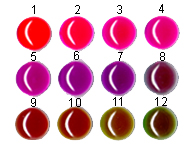
Home
Common Compounds
Exam Guide
FAQ
Features
Glossary
Construction Kits
Companion Notes
Just Ask Antoine!
Simulations
Slide Index
Toolbox
Tutorial Index
Introduction
Measurement
Matter
Atoms & ions
Compounds
Chemical change
The mole
Gases
Energy & change
The quantum theory
Electrons in atoms
The periodic table
Chemical bonds
Solids
Liquids
Solutions
| Acids & bases |
Reaction rates
Organic chemistry
Everyday chemistry
Inorganic chemistry
Environmental chemistry
Laboratory
History of chemistry
Miscellaneous
Home  FAQ FAQ  Acids and bases Acids and bases | Print | Comment |
| Previous Question | Next Question |
What is a universal indicator?
-
-
A universal indicator is a solution which undergoes several color changes over a wide range of pH's. The color is used to "indicate" pH directly. Universal indicators are usually mixtures of several indicators.
Vocabulary anthocyanin
acid
alkaline
base
indicator
pH
solution
universal indicator
 The easiest universal indicator to prepare is red cabbage juice. Stew red cabbage in water and pour off the water for
use as an indicator solution.
The pigment in red cabbage juice
is anthocyanin, which changes color from red in acid solution to purplish to
green in mildly alkaline solution to yellow in very alkaline solution. The color changes for red cabbage juice are shown to the right.
The easiest universal indicator to prepare is red cabbage juice. Stew red cabbage in water and pour off the water for
use as an indicator solution.
The pigment in red cabbage juice
is anthocyanin, which changes color from red in acid solution to purplish to
green in mildly alkaline solution to yellow in very alkaline solution. The color changes for red cabbage juice are shown to the right.
Another universal indicator is used in the classic 'chemical stoplight' demonstration, which changes from green to yellow to red as the pH goes from alkaline to acidic. The indicator is a solution that is 0.05% in each of the following: methyl red, methyl yellow, thymol blue, and bromthymol blue in ethanol[1].
References
- This recipe is taken from J. T. Riley, J. Chem. Ed., (54), 29 (1977).
General Chemistry Online! What is a universal indicator?
Copyright © 1997-2010 by Fred Senese
Comments & questions to fsenese@frostburg.edu
Last Revised 02/23/18.URL: http://antoine.frostburg.edu/chem/senese/101/acidbase/faq/universal-indicator.shtml